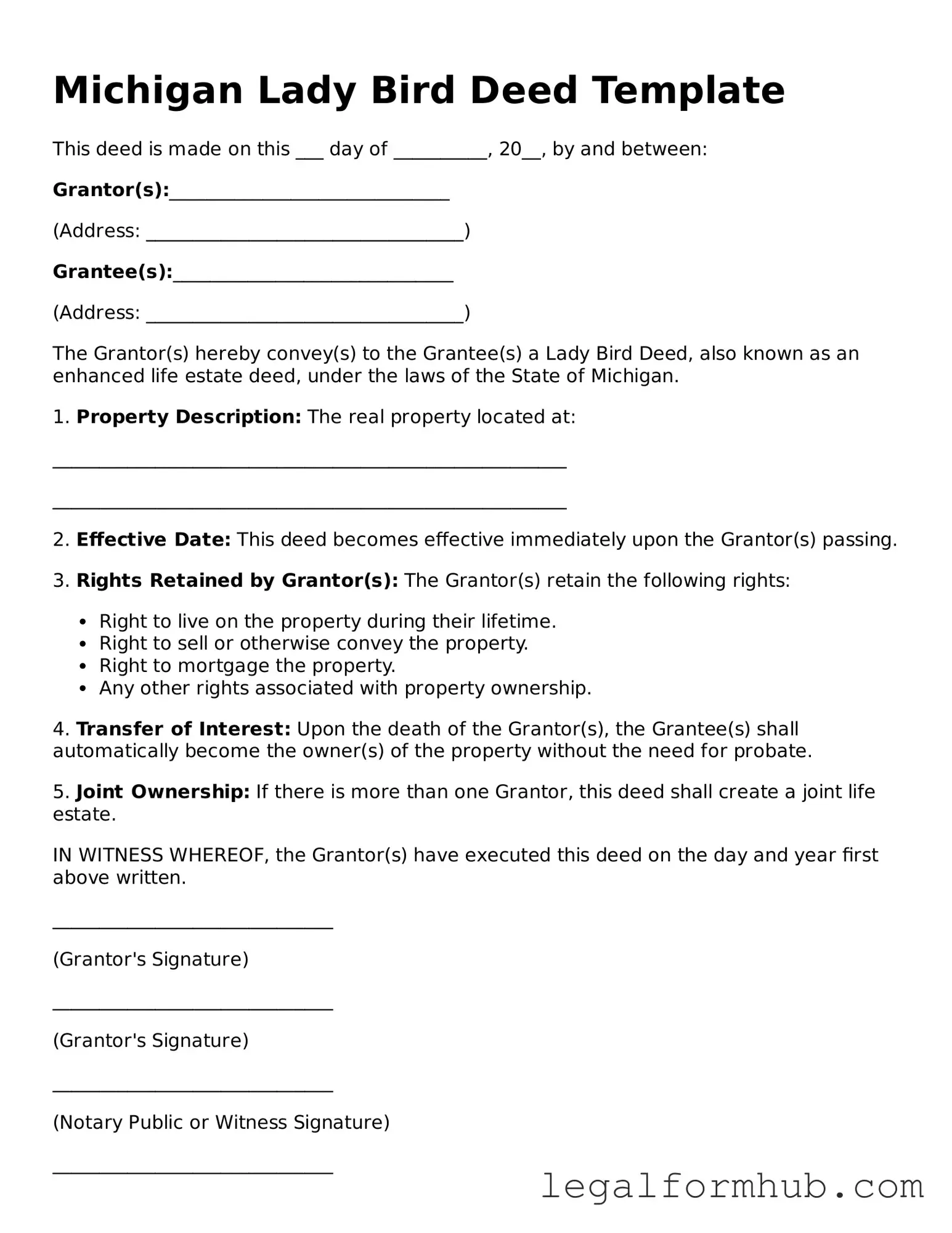The Michigan Lady Bird Deed is similar to a traditional life estate deed. Both documents allow a property owner to retain certain rights during their lifetime while transferring the remainder interest to a beneficiary. However, a life estate deed typically restricts the owner's ability to sell or mortgage the property without the consent of the remainderman. In contrast, the Lady Bird Deed provides greater flexibility, allowing the owner to sell or change the beneficiaries without needing permission, which can be particularly beneficial for estate planning purposes.
Another document comparable to the Lady Bird Deed is the quitclaim deed. A quitclaim deed transfers ownership of property without any warranties or guarantees regarding the title. While both deeds can be used to transfer property, the quitclaim deed does not offer the same level of control to the original owner. Once a quitclaim deed is executed, the original owner relinquishes all rights to the property, making it a less favorable option for those who wish to retain certain rights during their lifetime.
The warranty deed is also similar to the Lady Bird Deed, as it transfers ownership of property. However, a warranty deed provides a guarantee that the title is clear and free of any liens or encumbrances. In contrast, the Lady Bird Deed allows the original owner to retain rights while still transferring the property upon their death. This distinction makes the Lady Bird Deed a more flexible option for those concerned about future ownership and control over the property.
A revocable living trust shares similarities with the Lady Bird Deed in that both are used for estate planning. A revocable living trust allows the property owner to place their assets into a trust, which can be managed during their lifetime and distributed upon their death. While both documents avoid probate, the Lady Bird Deed allows for a simpler transfer of property without the need for ongoing management or oversight, making it an appealing choice for many individuals.
The transfer-on-death deed (TOD) is another document that aligns with the Lady Bird Deed. A TOD deed allows the property owner to designate a beneficiary who will automatically receive the property upon the owner’s death, bypassing probate. Like the Lady Bird Deed, the TOD deed enables the owner to retain full control of the property during their lifetime. However, the Lady Bird Deed offers more flexibility in terms of selling or transferring the property without losing the right to change beneficiaries.
In the realm of property transfers, understanding the various types of deeds is essential for smooth transactions. For motorcycle owners in Arizona, utilizing a specific template can ensure proper documentation of sales. For further details, visit arizonapdfs.com/motorcycle-bill-of-sale-template, which provides resources for creating a clear and legal motorcycle bill of sale.
The general power of attorney (POA) is also relevant when discussing the Lady Bird Deed. A general POA allows an individual to appoint someone else to manage their financial and legal affairs. While a Lady Bird Deed specifically addresses property transfer and retains rights for the original owner, a POA can be more comprehensive, covering various aspects of decision-making. Both documents provide a means of control, but they serve different purposes in managing assets and rights.
Another document that resembles the Lady Bird Deed is the enhanced life estate deed. This type of deed allows the property owner to retain the right to live in the property for their lifetime while transferring the remainder interest to a beneficiary. The key difference is that the enhanced life estate deed typically does not provide the same level of flexibility as the Lady Bird Deed, particularly regarding the ability to sell or change beneficiaries without consent.
Lastly, a joint tenancy deed is similar to the Lady Bird Deed in that it allows for shared ownership of property. In a joint tenancy arrangement, two or more individuals own the property together, and upon the death of one owner, the property automatically passes to the surviving owner(s). While this arrangement provides a straightforward transfer of ownership, it does not offer the same control over the property during the owner's lifetime as the Lady Bird Deed does, which can be crucial for estate planning.
